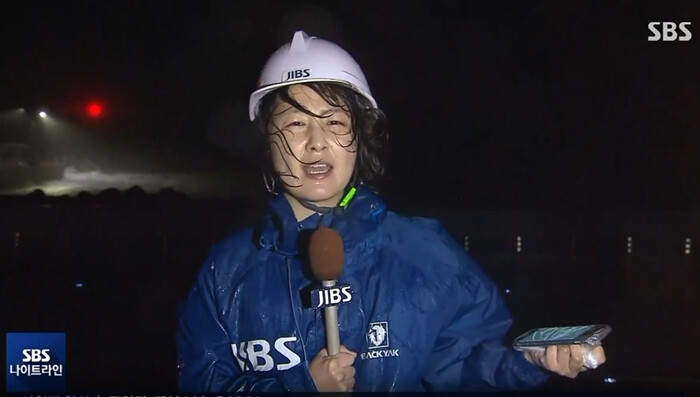
(C) SBS News
When a typhoon is raging, the ground is shaking, or a landslide has occurred in a natural disaster zone, we inevitably see reporters standing right there on TV. They are the ones struggling to maintain their balance against strong winds, directly exposed to the storm, clutching microphones in precarious spots next to collapsed buildings or fast-flowing rivers, delivering a breathless account of the critical situation. To the viewer, this may look like 'unwavering professionalism' dedicated to conveying the severity of the scene. However, what fills the viewer's heart is a greater sense of pity and anxiety. Does the news truly have to be delivered this way? This question is the uncomfortable truth that surfaces every time disaster reporting is repeated.
The reason reporters risk their safety to stand on the front lines is clear: to most effectively convey the severity of the disaster and heighten public awareness. The problem, however, is that the method of delivery is skewed towards demanding the 'maximization of risk.' Certain broadcasters cannot avoid criticism for unnecessarily pushing their reporters into dangerous situations simply to capture more dramatic and sensational footage.
This is not just an issue of reporting; it's a matter of human safety and a challenge to the ethical consciousness of broadcasting companies. Reporters and camera crews covering the scene may be professionals, but they are also human, vulnerable in the face of natural disaster. A momentary error in judgment or an unexpected change in the situation can instantly lead to a serious accident. There have been tragic cases in the past where journalists were injured or even killed while covering news. Broadcasters that foster a safety-blind attitude and treat valuable personnel as expendable under the guise of 'ratings' and 'scoop competition' deserve condemnation.
The core of disaster reporting should not be 'immediacy and spectacle' but 'accuracy and usefulness of information.' Instead of thrilling footage that boasts danger, providing essential analysis of the disaster, evacuation routes, government responses, and practical information for damage prevention from a safe location is far more public-spirited and valuable.
It is time for broadcasting companies to immediately abandon this outdated and dangerous competitive structure. Stop pushing reporters into harm's way. Disaster reporting must be a channel for delivering life-saving information, and the lives of those who create that channel must also be protected as the utmost priority. Delivering the most useful news from the safest location is the very definition of true journalistic responsibility. A form of reporting that endangers the safety of reporters is a disaster that must be stopped, just as much as one that endangers the safety of the public.
[Copyright (c) Global Economic Times. All Rights Reserved.]






























